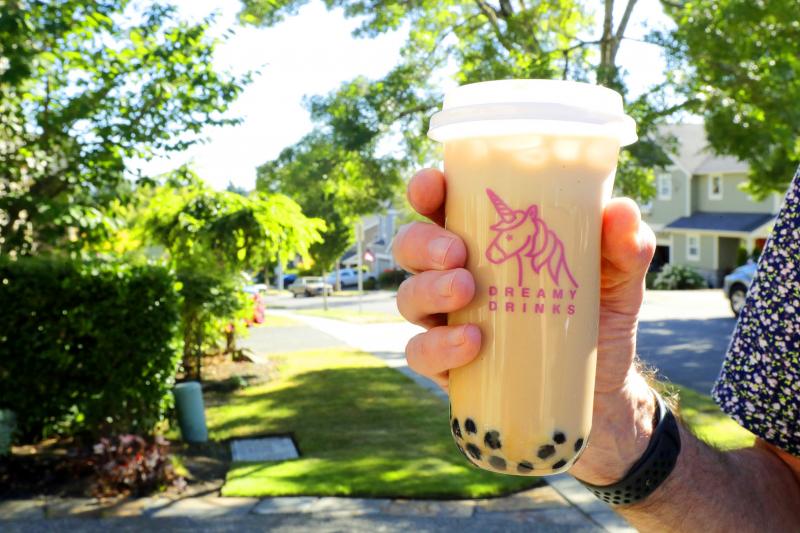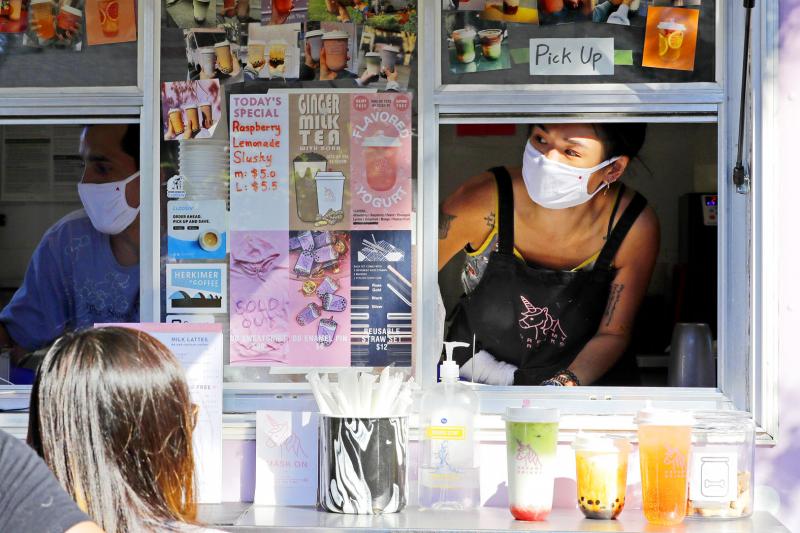Taiwan’s national drink, pearl milk tea, has taken the world by storm in recent years, and it is the addition of tapioca balls — also known variously as “pearls,” “boba” and “bubbles” — that creates the beverage’s unique flavor and textural experience. However, foreign media are reporting that logistical delays have caused both Taiwan-produced tapioca balls and tapioca powder from Thailand to be stuck inside shipping containers as the shipments await customs approval.
As the COVID-19 pandemic continues to wreak havoc on the global shipping industry, goods and commodities shipped from Asia, including Taiwan and Thailand, have become held up at US ports, caught up in a backlog of unprocessed shipments. This has led to shortages of some raw materials, causing many US drinks vendors to grumble nonstop. One such vendor has fumed that with no tapioca balls, many customers will not set foot inside the shop to buy a drink.
Oliver Yoon, global vice president of sales and marketing at Boba Direct, a pearl milk tea product supplier based in Arlington Heights, Illinois, US, says that about one month ago the company began to experience shortages of raw materials. Yoon adds that it is a nationwide crisis and says he expects the situation will not begin to improve until the end of the month.

Photo: AP 照片:美聯社
Tea & Others shop owner Alex Ou says some customers will not buy a drink if the shop has run out of boba, adding: “They are literally here for the boba.” Ou says he hopes that customers can be patient, since the shortage of raw materials is only temporary. Nonetheless, it is understandable that this is a depressing time for many businesses, adds Ou.
According to California-based supplier US Boba Co, 99 percent of boba comes from overseas, and although the company has a boba factory in the US, they are still reliant on imported tapioca starch. According to reports, in addition to bubble milk tea vendors, other US businesses are also suffering shortages. Starbucks has reported it is experiencing shortages of cups and sugar syrups, while the pandemic has also caused shortages of home fitness equipment, ice skates and furniture.
(Liberty Times, translated by Edward Jones)

Photo: AP 照片:美聯社
疫情導致全球航運大亂,一些台灣、泰國等亞洲國家貨物卡在美國港口排隊無法入關,導致珍珠奶茶「珍珠」的原料短缺,讓不少美國飲料店業者叫苦連天,更有業者抱怨,沒有「珍珠」讓許多顧客不願上門買飲料。
綜合外媒報導,近年風靡全球的台灣飲料「珍珠奶茶」,在飲料中添加珍珠創造獨特風味與口感,但因為運輸延誤,來自台灣的珍珠以及來自泰國用來製造珍珠的木薯粉,通通卡在船上貨櫃中等待進關。
位於芝加哥的珍奶產品供應商「Boba Direct」銷售副總奧利佛(Oliver Yoon)說,大概在一個月前就出現原料短缺情形,這是一場全國性的風暴,最快要等到四月底才能紓緩。
「Tea & Others」飲料店老闆艾利克斯(Alex Ou)則表示,如果沒有珍珠,一些顧客根本不願上門購買飲料,「他們都是為珍珠而來」。艾利克斯希望消費者能更有耐心。原料短缺只是暫時的,然而對其他業者來說,這件事的確讓人感到沮喪。
加州珍珠供應商「美國波霸公司」(US Boba Co.)表示,美國有百分之九十九的珍珠來自國外進口,即便他們在美國有自己的工廠,仍需要依靠國外進口木薯粉。報導指,除了珍珠奶茶外,星巴克也出現杯子和糖漿短缺情形,甚至健身器材、溜冰鞋、家具等其他產品,幾乎都受到影響。
(自由時報)

In an effort to fight phone scams, British mobile phone company O2 has introduced Daisy, an AI designed to engage phone con artists in time-wasting conversations. Daisy is portrayed as a kindly British granny, exploiting scammers’ tendency to target the elderly. Her voice, based on a real grandmother’s for authenticity, adds to her credibility in the role. “O2” has distributed several dedicated phone numbers online to direct scammers to Daisy instead of actual customers. When Daisy receives a call, she translates the scammers’ spoken words into text and then responds to them accordingly through a text-to-speech system. Remarkably, Daisy

Bilingual Story is a fictionalized account. 雙語故事部分內容純屬虛構。 Emma had reviewed 41 resumes that morning. While the ATS screened out 288 unqualified, she screened for AI slop. She could spot it a mile away. She muttered AI buzzwords like curses under her breath. “Team player.” “Results-driven.” “Stakeholder alignment.” “Leveraging core competencies.” Each resume reeked of AI modeling: a cemetery of cliches, tombstones of personality. AI wasn’t just changing hiring. It was draining the humanity from it. Then she found it: a plain PDF cover letter. No template. No design flourishes. The first line read: “I once tried to automate my

Every May 1, Hawaii comes alive with Lei Day, a festival celebrating the rich culture and spirit of the islands. Initiated in 1927 by the poet Don Blanding, Lei Day began as a tribute to the Hawaiian custom of making and wearing leis. The idea was quickly adopted and officially recognized as a holiday in 1929, and leis have since become a symbol of local pride and cultural preservation. In Hawaiian culture, leis are more than decorative garlands made from flowers, shells or feathers. For Hawaiians, giving a lei is as natural as saying “aloha.” It shows love and

1. 他走出門,左右看一下,就過了馬路。 ˇ He walked outside, looked left and right, and crossed the road. χ He walked outside and looked left and right, crossed the road. 註︰並列連接詞 and 在這句中連接三個述語。一般的結構是 x, y, and z。x and y and z 是加強語氣的結構,x and y, z 則不可以。 2. 他們知道自己的弱點以及如何趕上其他競爭者。 ˇ They saw where their weak points lay and how they could catch up with the other competitors. χ They saw where their weak points lay and how to catch up with the other competitors. 註:and 一般連接同等成分,結構相等的單詞、片語或子句。誤句中 and 的前面是子句,後面是不定詞片語,不能用 and 連接,必須把不定詞片語改為子句,and 前後的結構才相等。 3. 她坐上計程車,直接到機場。 ˇ She took a cab, which took her straight to the airport. ˇ She took a cab and it took her straight